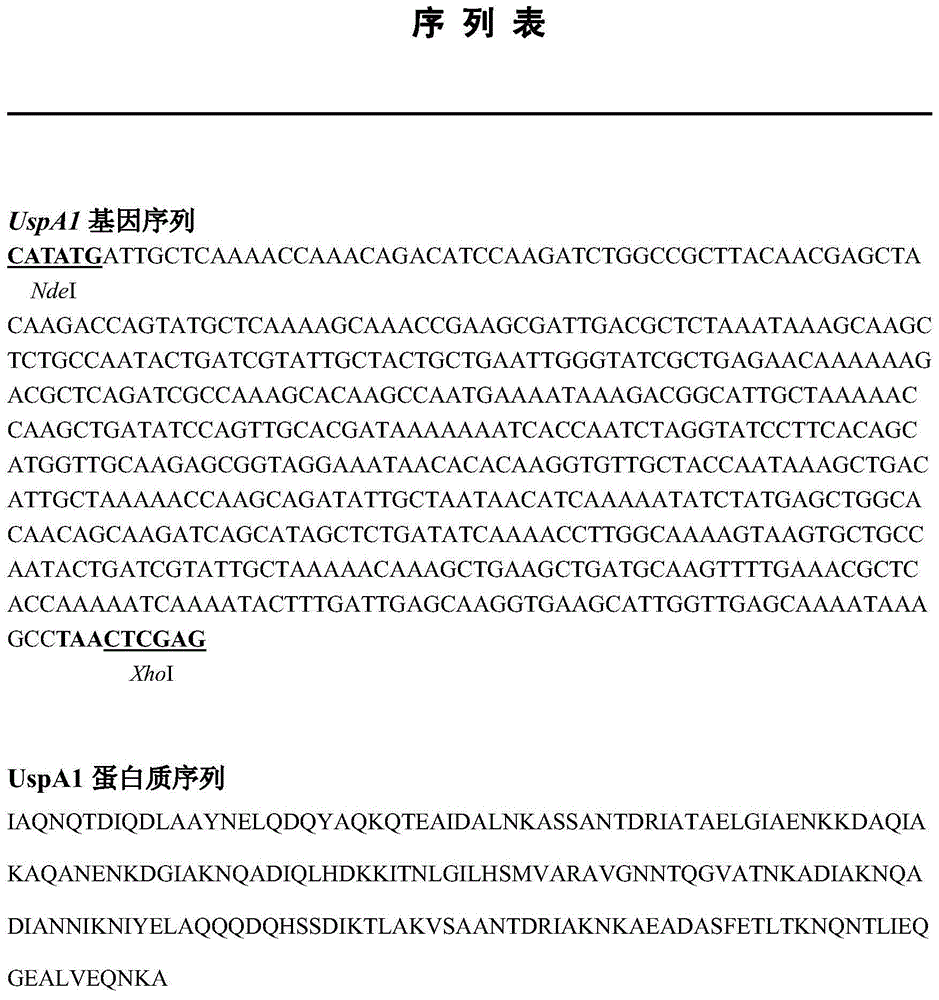Method and kit for fast detection of moraxella catarrhalis based on magnetic resolution and quantum dot labelling
A magnetic separation and quantum dot technology, applied in the field of medical detection, can solve problems such as complicated operation steps and long detection time
- Summary
- Abstract
- Description
- Claims
- Application Information
AI Technical Summary
Problems solved by technology
Method used
Image
Examples
Embodiment 1
[0083] Example 1 Preparation of Rabbit and Mouse Anti-Moraxella catarrhalis UspA1 Protein Polyclonal Antibody IgG
[0084] (1) Preparation and purification of recombinant UspA1-His fusion protein
[0085] 1. Cloning of related genes
[0086] Bioinformatics analysis was performed on the surface protein UspA1 of Moraxella catarrhalis (its accession number in the NCBI protein database is AAF36416), to obtain the peptide with the most abundant antigenic epitope in its extracellular conserved domain, and to find its corresponding DNA coding sequence At the same time, the whole gene sequence was chemically synthesized after introducing the restriction site NdeI at the 5' end, the termination signal TAA and the restriction site XhoI at the 3' end (the whole sequence synthesis was completed by GenScript Biotechnology Co., Ltd., upon delivery The artificially synthesized gene fragment is connected to the vector pUC57), which is denoted as UspA1. The full sequence of its gene is shown...
Embodiment 2
[0100] Example 2 Preparation of Anti-Moraxella catarrhalis Immune Nano Magnetic Beads
[0101] 1. Optimization of reaction conditions for anti-Moraxella catarrhalis polyclonal antibody coupled to magnetic beads:
[0102] Using magnetic beads coupled with anti-M. catarrhalis polyclonal antibody as a solid phase carrier, and quantum dot-labeled anti-M. Bacillus antigen, observe the coupling of magnetic beads and polyclonal antibodies. A series of optimization options were carried out on the particle size of the magnetic beads, as well as the concentration of EDC / NHS activator, the concentration of conjugated antibody, the coupling time, and the type of blocking agent.
[0103] 1.1 Selection of magnetic bead size
[0104] Carboxylated magnetic beads with a particle size of 50nm, 180nm, 350nm, 1150nm, and 3μm were selected, and after adding PBS buffer solution containing 4mg / mlEDC and 4mg / mlNHS for activation reaction, they were mixed with the rabbit anticatamol described in Exa...
Embodiment 3
[0115] Example 3 Preparation of quantum dot-labeled anti-Moraxella catarrhalis nanoprobes
[0116] 1. Optimization of IgG reaction conditions for nanocarboxyl quantum dot-labeled mouse anti-Moraxella catarrhalis UspA1 protein polyclonal antibody IgG:
[0117] 1.1. Determination of the optimal labeling pH of the carboxyl quantum dot-labeled antibody probe
[0118] The pH of the phosphate buffer in the labeling reaction was set to 5, 6, 7, 8, and 9 respectively, and the fluorescence intensity of the labeled product was measured with a full spectrometer, and the influence of different pH values on the coupling reaction was observed, and the quantum dot labeled polyclonal antibody was determined. The optimum pH for the reaction is 7.0-8.0. This experiment chooses pH7.4.
[0119] 1.2. Determination of the optimal labeling amount of carboxy quantum dot-labeled antibody probes
[0120] Set the ratio of quantum dot molar concentration to polyclonal antibody concentration to 1:1, ...
PUM
| Property | Measurement | Unit |
|---|---|---|
| particle diameter | aaaaa | aaaaa |
| strength | aaaaa | aaaaa |
| particle diameter | aaaaa | aaaaa |
Abstract
Description
Claims
Application Information
 Login to View More
Login to View More - R&D
- Intellectual Property
- Life Sciences
- Materials
- Tech Scout
- Unparalleled Data Quality
- Higher Quality Content
- 60% Fewer Hallucinations
Browse by: Latest US Patents, China's latest patents, Technical Efficacy Thesaurus, Application Domain, Technology Topic, Popular Technical Reports.
© 2025 PatSnap. All rights reserved.Legal|Privacy policy|Modern Slavery Act Transparency Statement|Sitemap|About US| Contact US: help@patsnap.com



